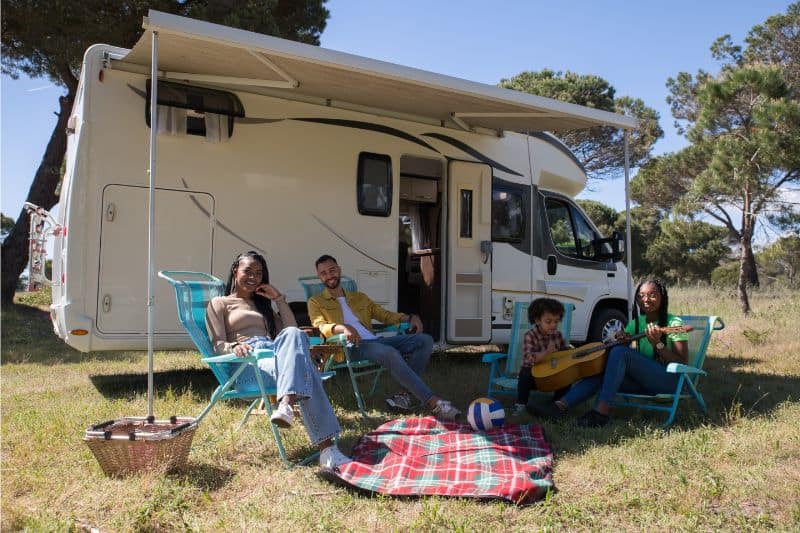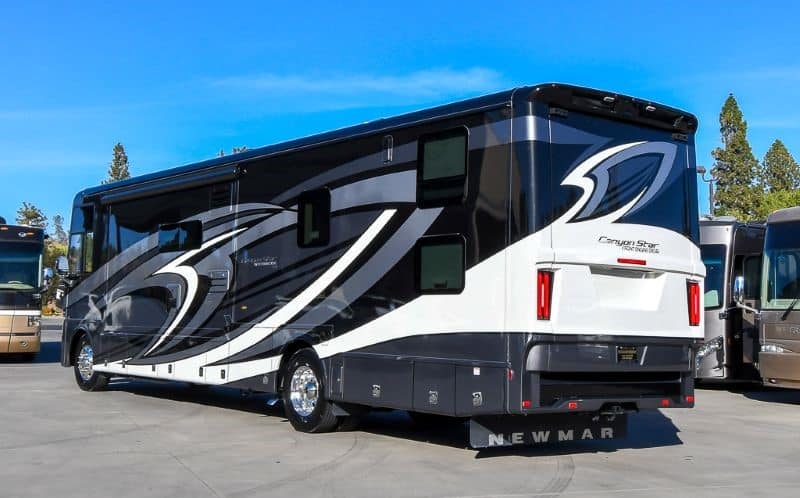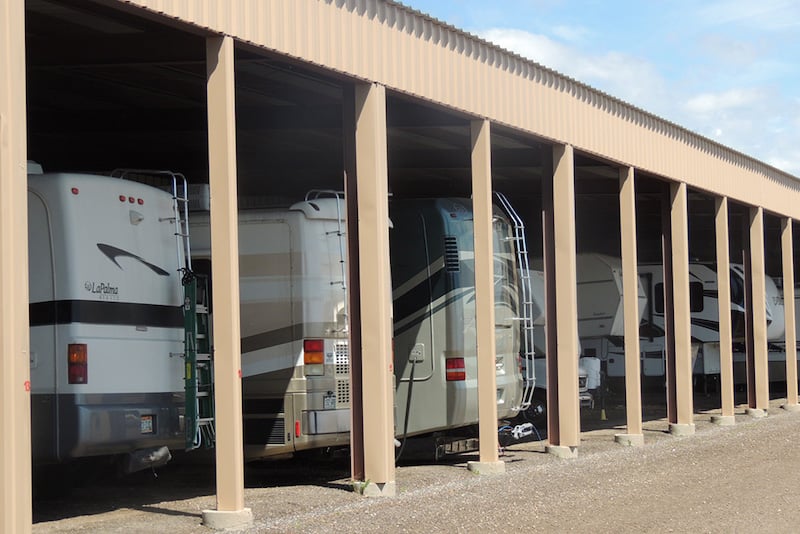RV awnings are a great way to enjoy some shade outside your RV. Few things are better than setting up some chairs and relaxing under your awning with a cold beverage on a hot day. But are RV awnings waterproof?
It’s a fair question to ask, especially if there’s rain in the forecast. After all, you don’t want your awning getting damaged or your things getting wet. In this article, we’ll go in-depth on RV awnings, whether or not they’re waterproof and more.
What Is An RV Awning?
Before we answer the question of “Are RV awnings waterproof,” let’s first define what an RV awning is.
RV awnings are fabric sun shades that extend from the side of your RV. They provide you shade and some protection from the elements when you’re outside your RV.
They can be made out of a few different materials, and they extend and retract from your RV using either a crank or a motor via the push of a button. If an awning has a motor, it will typically be referred to as a “power awning.”
Not all RVs have awnings, but they’re an extremely common feature for RVs. Even if an RV doesn’t come with an awning stock, it’s likely an option to add one.
What Material Are RV Awnings Made Out Of?
The majority of RV awnings are made out of either acrylic or vinyl fabric, which have slightly different properties.
Acrylic awnings are breathable, quick-drying, resistant to fading, and lighter weight. However, acrylic RV awnings are not fully waterproof and can allow water to slip through. Acrylic awnings are also more prone to stretching from water pooling on top.
When it comes to the question of “Are RV awnings waterproof,” vinyl awnings have a clear advantage. They’re fully waterproof and also prevent any UV rays from getting through. But, they’re more prone to mold and mildew.
Plus, because they aren’t breathable, they catch the wind more easily (and the area below them tends to be slightly warmer than for acrylic awnings). They’re also generally heavier than acrylic awnings.
Are RV Awnings Waterproof?
So, now we come to the question of “Are RV awnings waterproof?”
As we saw in the previous section, vinyl RV awnings are fully waterproof. Acrylic, meanwhile, is water resistant, but not fully waterproof.
With either type of RV awning, as long as they’re in good condition, they will repel some amount of rain and direct it away from your campsite. But, keep in mind that acrylic won’t stand up to quite as much rain.
Why Is My RV Awning Leaking?
If your RV awning is leaking, it could be caused by a few different things.
One possible cause is water pooling in the awning, and then seeping through. This is especially likely if you have an acrylic awning. Some awnings are designed to automatically dump water if they get too full, but in other cases, you’ll have to do this yourself to ensure proper function.
Small holes or rips are also a possible cause. These can be caused by wind stressing the fabric, or sticks and other materials creating holes over time. In cases like these, you can use an awning repair tape for an easy fix.
The final possibility, and the hardest to fix, is that your awning material has simply broken down over time. This can be due to sun exposure, mold, and mildew development, or simply because the material is old and worn out. In cases like these, your best option will be to simply replace the awning fabric. You can find RV awning replacement fabric on Amazon for just about every type of awning. And the cost is much less than you might think!
Can I Replace The Awning On My RV?
If you want to replace the awning on your RV yourself, it is definitely possible. However, it is a 2 to 3-person job and will require a bit of work and know-how on your part. You’ll need a ladder, and you’ll be working with springs under tension, so caution is extremely important to protect yourself and your RV.
It’s also possible to add an awning to an RV that doesn’t have one. But, keep in mind that this will be a pretty significant project to take on. Since you’re not just replacing material, you’ll need to do some drilling, and in the case of a powered awning, some wiring.
Because it’s a fairly demanding task, don’t be afraid to go with a pro if you aren’t up to the task (or don’t have extra hands to help). The extra money spent is well worth the peace of mind.
Can I Leave My RV Awning Out All The Time?
You might be tempted to leave your RV awning out all the time. This is especially true if your RV is generally stationary. But, there are a number of reasons that’s a bad idea.
While your awning can stand up to a bit of wind and rain, it’s not designed to withstand serious weather. If strong winds pick up while your awning is out, there’s a very good chance the force of the wind can tear the awning or otherwise damage it. Worse, the rogue awning could then damage your RV, damage other people’s property, or even hurt other people!
Heavy rains can also damage your awning, even without wind. If a large amount of water pools in the awning, it can cause severe damage to the awning, possibly even requiring replacement.
If you’re going to leave your awning extended, you should always check the local forecast to be prepared for any severe weather. And just to be on the safe side, it never hurts to retract your awning whenever you won’t be around. It only takes a minute, and could save you from a serious headache down the line!
One option for leaving the awning extended is to simply extend it slightly. That way, you can keep the sun from coming in the windows, but avoid it catching too much wind and becoming damaged. Even in this case, though, we recommend retracting your awning when you won’t be around.
5 FAQs About RV Awnings
Have questions? We have the answers. Let’s answer five of the most frequently asked questions about RV awnings.
1. Why Do RVs Have Awnings?
RV awnings are designed to provide shade and protect you from the elements when outside your RV.
Awnings help keep your RV cooler and give you some relief from the sun and rain when outdoors at your campsite. Not all RVs have awnings, however, it’s definetly more rare to see an RV without one.
2. Are RV Awnings Waterproof?
If you’re wondering, “Are RV awnings waterproof,” the answer depends on the material.
Acrylic awnings are water-resistant, but not waterproof. So they’ll hold up to a bit of rain, but some water will still get through, especially if it’s raining heavily.
Vinyl awnings are completely waterproof. Unless the fabric is damaged, vinyl RV awnings won’t let any water through. So, if you want a waterproof awning, we recommend going with vinyl if possible.
3. Can You Replace An RV Awning?
Yes, it’s totally possible to replace an RV awning, or even install one on an RV without one. However, these are both fairly demanding projects, especially installing an awning from scratch. You’ll need two to three people for the task, as well as the proper tools.
Because of this, in many cases, the best option is to have a professional replace or install your RV awning. That way, you can rest easy that you’ll have an expertly installed awning, without having to go through the trouble yourself.
4. How Do You Properly Care For Your RV Awning?
To properly care for your RV awning, there are a few things you should do:
- Avoid rolling up the awning when wet as much as possible. Wait for it to dry if you can before retracting. This helps ensure the longevity of the material and reduces the buildup of mold and mildew.
- Clean the awning at least once a year to remove any mold or mildew that has grown in the awning
- Avoid leaving your awning open if it is windy, and retract it anytime you won’t be around your RV
- Avoid letting water pool up on top of the awning, and if it does, be sure to empty it out promptly
By following these tips, you’ll ensure your awning keeps working properly for years to come. Replacing an awning can be expensive and challenging without help.
We wrote an article called Homemade RV Awning Cleaner for those of you looking to clean the mold and mildew off of your awning.
5. Should You Leave Your Awning Out All The Time?
While it may be tempting to leave your awning out all the time, especially if your RV is generally stationary, you should avoid this. Unexpected gusts of wind or strong rains can tear your awning right off your RV if it’s left extended.
Be sure to regularly check your forecast, and if there’s heavy rain coming, retract the awning. Also, any time you won’t be near your RV for any extended period of time, it’s recommended to retract the awning.
Final Thoughts: Are RV Awnings Waterproof?
So, are RV awnings waterproof? In some cases, yes, but not always.
If your RV awning is made with vinyl fabric, then yes, it will be waterproof. But if your awning is made of acrylic material, it will only be water resistant. This means it will protect you from some water, but too much, and water will begin to leak through.
Even though some RV awnings are waterproof, it’s recommended to retract them anytime there will be serious weather. While a light drizzle won’t be an issue, a serious storm can cause a number of problems.
Too much water will cause some awnings to sag, potentially causing tears and contributing to mold growth. Plus, if high winds pick up, they can tear your awning right off your RV. For those reasons, it’s recommended to retract your awning anytime severe weather is in the forecast.
With proper care, your RV awning will last for years and years. That way, you can rest easy (and dry!) in the shade.
– Essential Motorhome Spare Parts & Tools To Carry
– When to Turn on Your RV Tank Heaters
– Why Does My RV Furnace Blow Cold Air?
– How Often Do Motorhomes Break Down?
About the Author:
Ryan Milejczak (mill-LAY-check) is a full-time freelancer writer and Florida native with a passion for RVs.
Currently, he’s saving up to do his own camper van conversion, which he plans to take across the US and Mexico.
When he’s not writing, Ryan loves cooking, hiking, practicing his Spanish, and taking care of his plants (currently at 23 plants and counting!)




